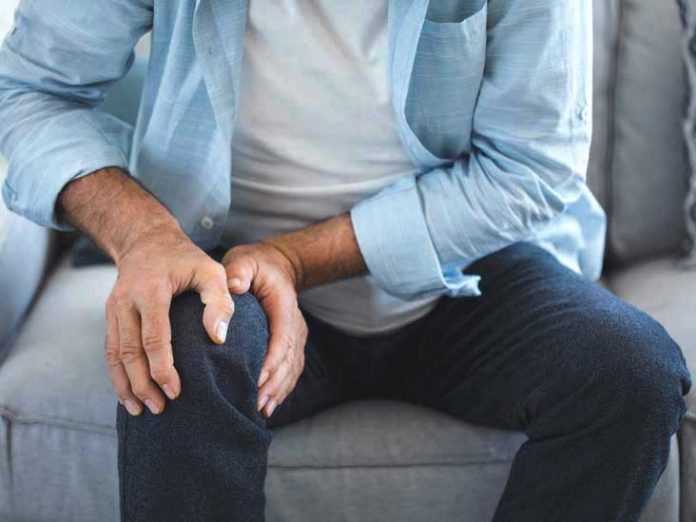According to the American College of Rheumatology (ACR), 27 million Americans over the age of 25 years suffer from osteoarthritis; this is the most common type of arthritis and is the most common cause of disability among seniors. Many who suffer from osteoarthritis take glucosamine supplements in the hope that it will relieved pan and prevent further deterioration of the joints. Unfortunately, a new study has found that glucosamine did not lessen knee cartilage deterioration.
The study authors note that glucosamine is the second most commonly-used natural product to treat osteoarthritis. A Gallup poll reported that 10% of Americans older than age 18 use glucosamine, which accrues more than $2 billion in global sales. The study group comprised 201 individuals who experienced mild to moderate pain in one or both knees. The researchers conducted a double-blind, placebo-controlled trial, meaning that the subjects were randomly assigned to receive either glucosamine or a placebo and neither the subjects nor the administrators of the medication were aware of which patients received the placebo. The trial was termed the joints on glucosamine (JOG) study. The participants received 1,500 mg of glucosamine hydrochloride or a placebo daily. The glucosamine or placebo was contained in a 16-ounce bottle of diet lemonade. The patients underwent magnetic resonance imaging (MRI) to assess cartilage damage.
The investigators found no difference in worsening of cartilage damage in participants in the glucosamine group compared to the placebo group. The investigators also found a lack of advantage of glucosamine over placebo for improvement in bone marrow lesions. C-telopeptides of type II collagen (CTX-II) is a predictor of cartilage destruction.. the investigators found that glucosamine did not decrease urinary excretion of CTx-II; thus, indicating that glucosamine did not curb joint destruction.
The investigators note that their JOG study is the first to evaluate whether a glucosamine supplement prevents the worsening of cartilage damage or bone marrow lesions. They concluded that their study found no evidence that drinking a glucosamine supplement reduced knee cartilage damage, relieved pain, or improved function in individuals with chronic knee pain.
Osteoarthritis is characterized by the breakdown of joint cartilage. Although it can occur in any joint, usually it affects the hands, knees, hips, or spine. Osteoarthritis can be classified as primary or secondary. Primary osteoarthritis has an unknown cause, while secondary osteoarthritis is caused by another disease, infection, injury, or deformity. As the cartilage wears down, the bone ends may thicken, forming bony growths or spurs that interfere with joint movement. In addition, bits of bone and cartilage may float in the joint space and fluid-filled cysts may form in the bone, limiting joint movement. Several risk factors are associated with osteoarthritis, including the following:
- Heredity: Slight joint defects or double-jointedness (laxity) and genetic defects may contribute to the development of osteoarthritis.
- Obesity: Excessive weight can put undue stress on such joints as the knees over time.
- Injury or overuse: Significant injury to a joint, such as the knee, can later result in osteoarthritis. Injury may also result from repeated overuse or misuse over a period of time.
The most common symptom of osteoarthritis is pain after overuse of a joint or prolonged inactivity of a joint. Symptoms of osteoarthritis usually develop slowly over many years. The following are the most common symptoms of osteoarthritis. However each individual may experience symptoms differently. Symptoms may include:
- Joint pain
- Joint stiffness, especially after sleeping or inactivity
- Limited joint movement as the disease progresses
- Grinding of joints when moved (in more advanced stages of osteoarthritis) as the cartilage wears away
The symptoms of osteoarthritis may resemble other medical conditions or problems. Always consult your doctor for a diagnosis.
In addition to a complete medical history and physical examination, the most common way to diagnose osteoarthritis in a joint is by X-ray. Specific treatment for osteoarthritis will be determined by your doctor based on:
- Your age, overall health, and medical history
- Extent of the condition
- Your tolerance for specific medications, procedures, and therapies
- Expectation for the course of the condition
- Your opinion or preference
The goals of treatment for osteoarthritis are to reduce joint pain and stiffness, and improve joint movement. Treatment may include:
- Exercise: Regular, aerobic exercise, and stretching and strengthening exercises may help reduce the symptoms of and pain associated with osteoarthritis.
- Heat treatment: Treating the affected joint with heat may help reduce pain.
- Physical and occupational therapy: Physical and occupational therapy may help to reduce joint pain, improve joint flexibility when performing daily activities, and reduce joint strain. Splints and other assistive devices may also be used.
- Weight maintenance: Maintaining your recommended weight or losing weight (if overweight) may help to prevent or reduce the symptoms of osteoarthritis.
- Medication: Medication for specific symptoms may include pain relievers (in pill form or topical cream) and anti-inflammatory medications, if inflammation is present.
- Injections of thick liquids into the joints: These liquids mimic normal joint fluid.
- Joint surgery: Surgery may be necessary to repair or replace a severely damaged joint.








